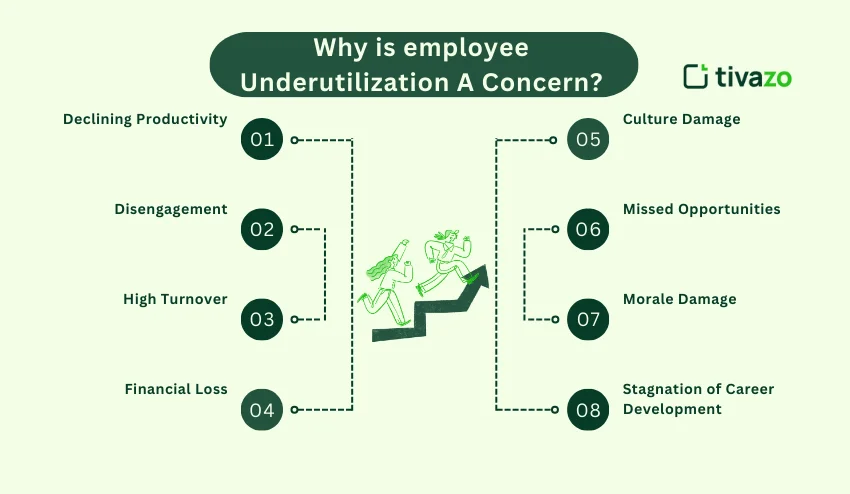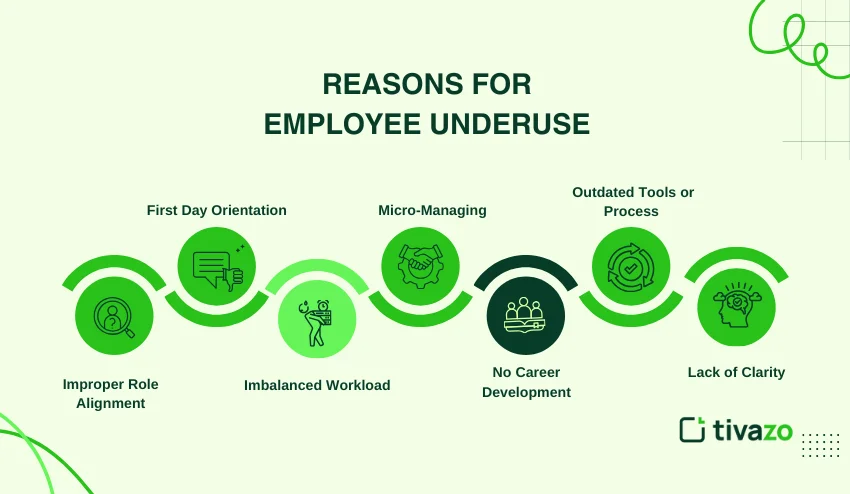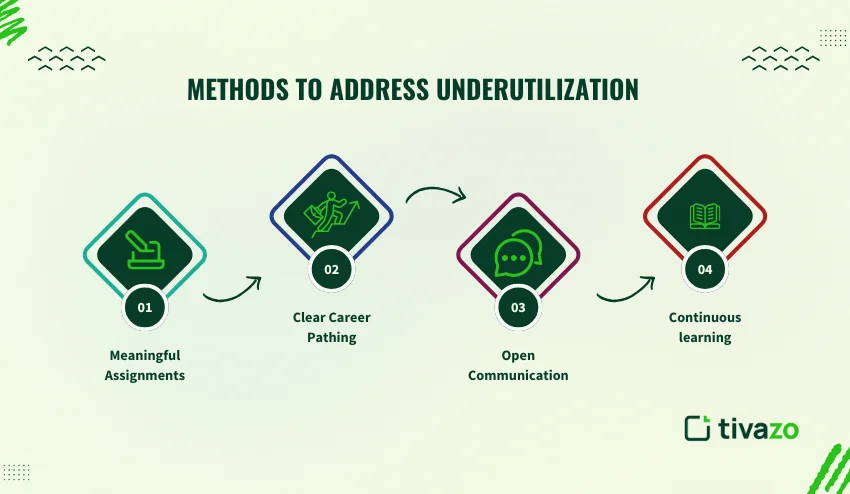Every organization aspires to unlock the potential of its people. One less visible, yet silent, drain of productivity is the underutilized employee. When skills, abilities, and effort are being squandered, both employee and organization suffer. The underutilized employee leads to disengagement, low morale, and even turnover.
Not only does the underutilized employee impact performance individually, but it also impacts the team and the organization as a whole. Ignoring the potential of an underutilized employee has consequences beyond individual performance, including missed opportunities, impeded innovation, and an increasingly disengaged employee population. It is important to understand how to identify an underutilized employee and how to support him or her because building a productive, motivated, and satisfied team is the best way to success.
In this blog, we’ll explain everything you need to know about an underutilized employee, including what it means, why it matters, real-world examples, causes of underutilization, and ways to fix it. Whether you’re a manager seeking to do your best work to optimize your team, or whether you’re an individual and you encounter feels underutilized at work, this blog is designed for you.
What Is Employee Underutilization?
Employee underutilization occurs when employees are not applying their skills, knowledge, or potential to their work. Their capacity exceeds their assigned tasks.
For instance, a person in marketing who qualifies as an “analytical” professional might be asked only to write social media posts. The person can do the job, but their ability to use any data is wasted, and they could even become frustrated.
In summary, an underutilized employee is someone who is capable of doing more but is not allocated the opportunity.
Signs of an Underutilized Employee:
- Assigned tasks are often below their skill level, knowledge, and/or expertise.
- They are often not engaged in any decision-making or problem-solving.
- They have not been given opportunities for professional development and/or training.
- Any relevant skills and ideas are overlooked or underutilized.
- They express boredom, disengagement, or low motivation.
- The workload does not challenge their true potential.
Identifying employees who are underutilized is only the first step in increasing productivity and motivation in the workforce. By identifying the underused employee, management is in a better position to create opportunities to help unlock untapped potential, to reintegrate disengaged employees, and to help improve team dynamics overall.
Why is employee underutilization a concern?
Ignoring underutilization comes at a cost. Studies estimate that disengaged employees lead to lost productivity of $450 – $550 billion in the U.S. alone.
Here’s why this is a problem:
- Declining Productivity: Skills are utilized, and there is a lack of innovation. An underutilized employee is less likely to contribute ideas or take initiative.
- Disengagement: Employees may feel unappreciated if they realize they are not being utilized to their potential, making them less motivated.
- High Turnover: When an employee feels they are not being challenged, they may evaluate other employment opportunities, thus increasing turnover and high recruitment and training costs.
- Financial Loss: Inefficiency leads to the cost of operating increasing in any organization and translates to reducing the profit margins for the organization.
- Culture Damage: Colleagues perceive an employee’s disengagement, and this becomes contagious across the team, and ultimately, involvement declines.
- Missed Opportunities: An organization misses out on creative solutions and problem-solving capabilities from high-level employees by ignoring an underutilized employee.
- Morale Damage: An employee who sees another employee underutilized may feel uncertain about their own professional growth and contributions to the organization.
- Stagnation of Career Development: An underutilized employee becomes stagnant regarding new professional development and stops adopting new skills, which has a longer-term limitation for the organization.
When 79% of employees report being disengaged at work, it is evident that underutilization is a significant component of workplace dissatisfaction and lost opportunity. It is essential to manage this issue to fulfill the employee and gain the value of the organization.

What Does It Mean to Be Underutilized at Work?
For employees, being underutilized at work means:
- Completing repetitive, low-value assignments.
- Not being included in discussions on key decisions.
- Possessing advanced abilities that no one recognizes.
- Being stuck with no chance of learning.
Being underutilized doesn’t mean working less; it means you are working beneath your capability and potential. An underutilized employee will generally feel annoyed, bored, and disengaged because no one is calling upon their full talent.
Other indicators of being underutilized include:
- Being left out of challenging projects or strategic initiatives.
- Receiving very little feedback or recognition for your skills or accomplishments.
- Feeling invisible on your team, even while you have useful skills.
- Spending the bulk of your workday on tasks that are not aligned with your talents.
Organizations that don’t engage an underutilized employee face the risk of losing great talent, lowering morale across teams, & missing innovation opportunities. Employees identifying for underutilization are the first step in having the opportunity to seek without permission, take initiative, and look for ways to contribute at higher levels.
Reasons for Employee Underuse
There are several factors that lead to employees being underused.
1. Improper Role Alignment
Employees are hired for one role and given tasks that do not align. An underused employee may have exceptional skill levels but will not think about using those skills in their day-to-day tasks and will experience a lack of engagement.
2. Poor Communication
Managers do not understand the skills of employees, their interests, or the goals that they have for their careers. Poor communication leaves an underused employee unnoticed, leading to challenges for an employee with the potential to exceed.
3. Imbalanced Workload
Some employees receive too much work, and some employees do not need any work at all. Often, some employees are underused in part because of poor assignment of tasks, wasting the potential of one employee, while causing burnout for an overloaded employee.
4. Micro-Managing
Leaders who micro-manage every detail of a situation limit the ability of others to act independently. The effect of micromanagement is an underused employee who cannot take ownership of the task or is unable to try new, innovative actions.
5. No Career Development
No training, no projects, and no mentor means there will be little growth. When a person is not offered developmental opportunities, that employee becomes an underused employee as they begin to stall in their careers.
6. Outdated Tools or Process
Employees who have only outdated tools cannot use their knowledge or skills to their fullest extent. An underused employee is seen as having limited productivity and creativity once he/she is stuck in a system or process.
7. Lack of Clarity
Without a defined target, using an executive-level employee as an underused employee can be a well-intended response. An employee’s motivation and accountability could decline due to a lack of clear expectations.

Methods to Address Underutilization
| Method | How It Helps |
| Job Rotation | Allows employees to become acquainted with new challenges, while also allowing an underutilized employee to discover and demonstrate their hidden skills. |
| Cross-training | Increases flexibility and use of skills so an underutilized employee can spend time contributing in multiple areas. |
| Mentorship programs | Encouraging knowledge sharing and directing an underutilized employee will build their confidence and help them broaden their expertise. |
| Employee feedback systems | Employee feedback can help identify early signs of underutilization and allow the manager to work proactively to engage an underutilized employee. |
| Recognition Programs | Motivates employees to perform to their fullest, recognizing an underutilized employee’s worth and encouraging contributions. |
Other methods include:
- Meaningful Assignments: Meaningful assignments to an underutilized employee can lead to re-engagement and growth chances.
- Clear Career Pathing: A numbered growth path completely shows an underutilized employee how to advance and leverage more expertise.
- Open Communication: Encourages dialogue between employees and managers to recognize underutilization and match skills with tasks.
- Continuous learning: Workshops, courses, and training are offered to an underutilized employee to encourage expansion of their capabilities to allow for taking on more complex and challenging work
An organization can turn an underutilized employee into a fully engaged, high-performing team member, enhancing morale and productivity by using these methods.

The percentage of employees who are engaged at work is as high as 79%
Gallup’s research indicates that the overwhelming majority (79%) of employees do not feel engaged at work. One primary reason for this high number is employee underutilization. When employees feel their skills, talents, and ideas are overlooked, they are less motivated and engage and expend energy towards work.
Why Does Employee Disengagement Occur?
Many reasons may lead to feelings of disengagement, such as:
- Employees are not challenged and are not allowed to use their full potential
- Not having recognition for contributions
- No growth path for career and learning
- Ineffective communication between managers and employees
How does employee underutilization lead to disengagement?
An underutilized employee inherently believes that they are undervalued and unimportant. This belief can lead to significant implications regarding productivity, morale, and retention. Addressing underutilization can have a broad impact on an employee’s level of disengagement and create more overall satisfaction in work.
| Cause | Impact on Employees | How to Address |
| Skills not used | Boredom, frustration | Creatively assign meaningful tasks and projects |
| Lack of recognition | Low motivation | Recognize employee contributions |
| No growth path | Not going anywhere | Develop a training plan and offer mentorship |
| Ineffective communication | Not heard | Encourage feedback |
If an organization can identify an underutilized employee and develop a plan for engaging that employee, the organization will unlock hidden potential and not only innovate but also see higher productivity and morale in the organization overall. Engaged employees are more productive, offer more than one idea, and are far less likely to leave the organization.
Acknowledging Underutilization at Work: Steps to Resolving Underutilization
For Employers:
- Conduct employee surveys: Ask employees what they believe they may be underutilized in. This can help ferret out an employee’s true potential while also allowing the employer to determine if there are any underutilized employees.
- Connect skills to responsibilities: Assign tasks that leverage the skills an employee has trained to master, rendering their engagement and effectiveness higher.
- Professional training/development: Developmental opportunities in training, learning, and mentoring will ensure that underutilized employees will be secure enough to grow and receive difficult projects to tackle.
- Recognize and reward value add: Recognition will drive an employee and demonstrate value based on the employee’s noted skills.

For Employees:
- Speak to your competencies of skills: Speak to managers about your knowledge, which will not render you an underutilized employee.
- Leverage challenging drafts: Find the challenging requests made in your area of expertise, as this may or shall drive organizational outcomes for your portfolio and job realm. Conclusively showing employment experience potential.
- Take initiative: Be anything beyond your job specifications or the specified methodologies.
- Learn, learn, and adapt: Continuous growth, an employee can learn and decrease the potential for becoming underutilized in skills.
There is a healthy balance of facilitation required between the employer and employee for the engagement to fully employ an underutilized employee, which will subsequently yield contributions to organizational productivity and success!
Conclusion
An underused employee is someone who is not utilizing their knowledge, skill, and ability in their job. Consequently, an underused employee can become disengaged, and their productivity can decline. There are many reasons for an employee to become underused, including poor alignment of their role, micromanagement, a perceived lack of growth opportunities, and ineffective communication.
Employers can reduce underutilization of employees by assigning tasks based on skill, providing upskilling opportunities, and acknowledging employee contributions. An employee can speak up, become an active participant by volunteering for opportunities to take on challenging tasks, and pursue a combination of formal and informal upskilling. Reducing underutilization and providing opportunities for employees to be used will improve levels of engagement, productivity, and job satisfaction for both the individual employee and the organization.




